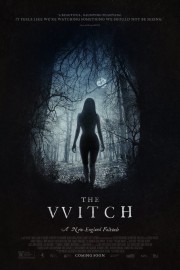The Witch
“The Witch” is, honestly, the movie I wanted M. Night Shyamalan’s “The Village” to be back in 2004 before the “Sixth Sense” auteur felt the need to pull the rug out from underneath the reality he had created onscreen with one of his patented “twists.” I get why he did it, but I wish he hadn’t. It would have shown that he could tell a straightforward thriller narrative and pay it off without trickery. He has never been the same filmmaker since. Thankfully, “The Witch” plays right to a conclusion that is surprising, but quite expected for the film writer-director Robert Eggers has created.
One of the most fascinating documentaries I have is the PBS miniseries, “God in America,” which looks at the evolution and conflict of religion in America since even before it was a country. In the first episode, it looks at New England society during Puritan times, and the controversy of Anne Hutchinson, who turned herself into an influential religious figure in 17th Century America with her ideas on religion and it’s power within the individual. Bold notions, which would get her exiled from one New England settlement. This story made its way into my head as I watched the beginning of Eggers’s film, where we start by watching children and a mother pray as the father, William (Ralph Ineson), argues with a tribunal who is about to banish he and his family for blasphemy. They leave the village, find land for themselves to build a home and live off the land, and they begin to make a life for themselves. William and Katherine (Kate Dickie) are the God-fearing parents, and they have four children- the oldest daughter, Thomasin (Anya Taylor-Joy); the oldest son, Caleb (Harvey Scrimshaw); twins Mercy (Ellie Grainger) and Jonas (Lucas Dawson), and baby Samuel. One day, Thomasin is playing peek-a-boo with Samuel in the cornfield, and when Thomasin’s eyes are covered one time, Samuel has disappeared, and we see Thomasin look into the foreboding woods screaming his name. Thus begins the family’s long nightmare that will tear it apart.
One of the most compelling things for me in a horror film is the way religion is approached, and how spiritual matters collide with the supernatural elements of horror to create a paranoid level of suspense in a narrative. Obviously, religion doesn’t always have a place in horror films, but when it finds it’s way in, it can lead to some fascinating looks at certain ideas and be insightful of the time in which the film takes place. In “The Witch,” Christianity and witchcraft are treated as two sides of the same coins; they are not simply abstract notions but very real forces, as is sin. The tagline for the film is “A New England Folktale,” and I can certainly imagine this story being passed on through the generations as a cautionary tale that illuminates the importance of giving yourself to God and staying away from impure thoughts that might lead you down the path of the devil and paganism. Mercy and Jonas, who like to torment Thomasin (who feels guilt for losing Samuel, and feels nothing but contempt from her always-praying mother) with kiddie games, are twice seen playing with a black goat the family has, even giving it the name “Black Phillip.” The goat is the traditional appearance of the devil, so to Thomasin and their parents, the idea of Mercy and Jonas being close to Black Phillip implies a literal congress with Satan himself, and it’s Mercy and Jonas who who like to taunt Thomasin about her being a witch. When the white goat she is milking at one point starts to release blood instead of milk, it’s a genuinely terrifying moment for all. For Caleb, he is being brought up as a strong young man and hunter by his father, but he is not above impurity, either, as he has begun to notice Thomasin’s body as she transitions into womanhood; it’s a subtle nuance but powerful when taken in the context of sin and how on-the-edge the family is between Godliness and being torn apart by evil at every turn in this film. The suspense of the film is drawn out through the characters, how they each relate to Christianity and what happens when their behavior seems to hint at something sinister eating away at them, like being unable to remember the words of a prayer they had said countless times before.
How Eggers is able to give us a convincing sense of time and place, in keeping with the “folktale” he is telling, is what really turns “The Witch” into something uniquely memorable among modern horror. If you were to simply put the most necessary dialogue on title cards, this could easily be a silent film, and stand up with the greatest of them handily. The film could be based on actual stills from life in 17th Century New England, and Eggers and his team- cinematographer Jarin Blaschke and production designer Craig Lathrop- capture it beautifully, with Mark Korven’s score raising the tension considerably. What makes it work, though, are the performances Eggers gets from his cast. Children are tricky to get believable performances out of, and horror feels particularly difficult, as you want to make sure you don’t traumatize the child with nightmares for the rest of their life. But Eggers accomplishes much in the work he elicits from his young actors, who all have at least one moment that is devastatingly terrifying and completely honest, with Scrimshaw, in particular, doing tricky scenes beautifully. The star of the film, though, is Taylor-Joy, who does more with her face and mannerisms than some people can do with words in a horror movie. She is the center of the film, and watching her be the focal point of this familial nightmare is an unsettling and unforgettable experience. You won’t be able to shake it.










